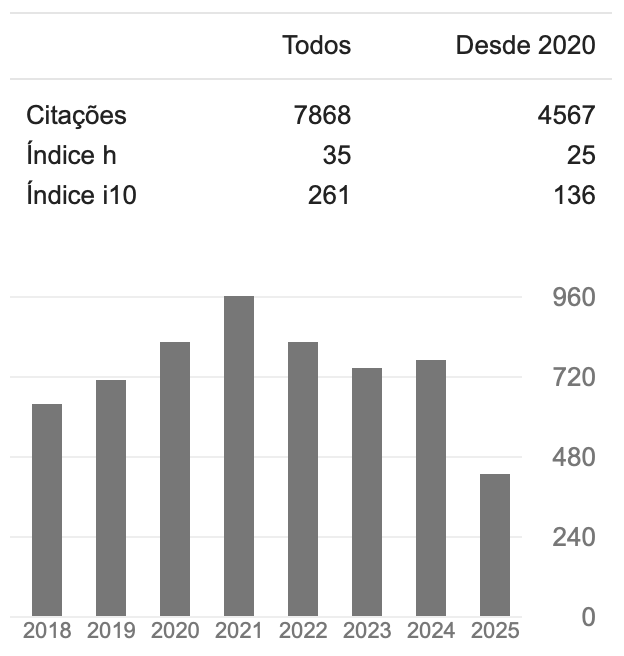Efeito de um programa multicomponente sobre a aptidão física relacionada à saúde em escolares
DOI:
https://doi.org/10.17765/2176-9206.2021v14n1.e8863Palavras-chave:
Aptidão física, Atividades esportivas, Educação nutricional, Educação básicaResumo
Este estudo avaliou o efeito de um programa multicomponente sobre a aptidão física relacionada à saúde em escolares. A amostra foi composta por 120 alunos do ensino infantil e fundamental divididos aleatoriamente em dois grupos: grupo intervenção que realizou um programa multicomponente de atividades físico-desportivas e educação nutricional (GI; n=60) e grupo controle que não participou do programa (GC; n=60). Foram avaliados o estado nutricional, VO2máx., força/resistência muscular e flexibilidade no início e no final de 12 semanas. Os resultados mostraram que o grupo GI modificou o estado nutricional e aumentou o VO2máx., a força/resistência muscular e a flexibilidade (p<0,0001). No GC o VO2máx., não se alterou, a força/resistência muscular diminuiu (p<0,0001). A flexibilidade no GC foi menor, quando comparada ao GI (p<0,0001). Em conclusão, o programa multicomponente melhorou a aptidão física relacionada à saúde dos escolares da educação básica.Downloads
Referências
Sutherland R, Campbell E, Nathan N, Wolfenden L, Lubans DR, Morgan PJ, et al. A cluster randomised trial of an intervention to increase the implementation of physical activity practices in secondary schools: study protocol for scaling up the Physical Activity 4 Everyone (PA4E1) program. BMC Public Health. 2019;19(1):883.
Hollis JL, Sutherland R, Campbell L, Morgan PJ, Lubans DR, Nathan N, et al. Effects of a 'school-based' physical activity intervention on adiposity in adolescents from economically disadvantaged communities: secondary outcomes of the 'Physical Activity 4 Everyone' RCT. Int J Obes. 2016;40(10):1486-93.
Rossi CE, Costa LCF, Machado MS, Andrade DF, Vasconcelos FAG. Fatores associados ao consumo alimentar na escola e ao sobrepeso/obesidade de escolares de 7-10 anos de Santa Catarina, Brasil. Ciênc Saúde Coletiva. 2019;24:443-54.
Afshin A, Forouzanfar MH, Reitsma MB, Sur P, Estep K, Lee A, et al. Health effects of overweight and obesity in 195 countries over 25 years. N Engl J Med. 2017;377(1):13-27.
Cooper AR, Goodman A, Page AS, Sherar LB, Esliger DW, van Sluijs EM, et al. Objectively measured physical activity and sedentary time in youth: the International children's accelerometry database (ICAD). Int J Behav Nutr Phys Act. 2015;12:113.
Jørgensen SE, Jørgensen TS, Aarestrup AK, Due P, Krølner R. Parental involvement and association with adolescents' fruit and vegetable intake at follow-up: Process evaluation results from the multi-component school-based Boost intervention. Int J Behav Nutr Phys Act. 2016;13(1):112
Fernandez-Jimenez R, Santos-Beneit G, Tresserra-Rimbau A, Bodega P, de Miguel M, de Cos-Gandoy A, et al. Rationale and design of the school-based SI! Program to face obesity and promote health among Spanish adolescents: A cluster-randomized controlled trial. Am Heart J. 2019;215:27-40.
Kobel S, Wirt T, Schreiber A, Kesztyus D, Kettner S, Erkelenz N, et al. Intervention effects of a school-based health promotion programme on obesity related behavioural outcomes. J Obes. 2014;476230; 1-8.
Li B, Pallan M, Liu WJ, Hemming K, Frew E, Lin R, et al. The CHIRPY DRAGON intervention in preventing obesity in Chinese primary-school--aged children: A cluster-randomised controlled trial. PLoS Med. 2019;16(11):e1002971.
Telford RM, Olive LS, Cochrane T, Davey R, Telford RD. Outcomes of a four-year specialist-taught physical education program on physical activity: a cluster randomized controlled trial, the LOOK study. Int J Behav Nutr Phys Act. 2016;13:64.
Evans A, Ranjit N, Hoelscher D, Jovanovic C, Lopez M, McIntosh A, et al. Impact of school-based vegetable garden and physical activity coordinated health interventions on weight status and weight-related behaviors of ethnically diverse, low-income students: Study design and baseline data of the Texas, Grow! Eat! Go! (TGEG) cluster-randomized controlled trial. BMC Public Health. 2016;16(1):973.
Habib-Mourad C, Ghandour LA, Moore HJ, Nabhani-Zeidan M, Adetayo K, Hwalla N, et al. Promoting healthy eating and physical activity among school children: findings from Health-E-PALS, the first pilot intervention from Lebanon. BMC Public Health. 2014;14:940.
Eather N, Morgan PJ, Lubans DR. Improving health-related fitness in children: the Fit-4-Fun randomized controlled trial study protocol. BMC Public Health. 2011;11:902.
Bansilal S, Vedanthan R, Kovacic JC, Soto AV, Latina J, Bjorkegren JLM, et al. Rationale and Design of Family-Based Approach in a Minority Community Integrating Systems-Biology for Promotion of Health (FAMILIA). Am Heart J. 2017;187:170-81.
Peñalvo JL, Santos-Beneit G, Sotos-Prieto M, Bodega P, Oliva B, Orrit X, et al. The SI! Program for Cardiovascular Health Promotion in Early Childhood: A Cluster-Randomized Trial. J Am Coll Cardiol. 2015;66(14):1525-34.
Santos-Beneit G, Bodega P, de Miguel M, Rodríguez C, Carral V, Orrit X, et al. Rationale and design of the SI! Program for health promotion in elementary students aged 6 to 11 years: A cluster randomized trial. Am Heart J. 2019;210:9-17.
Venckunas T, Mieziene B, Emeljanovas A. Aerobic Capacity Is Related to Multiple Other Aspects of Physical Fitness: A Study in a Large Sample of Lithuanian Schoolchildren. Front Physiol. 2018;9:1797.
Zhang M, Schumann M, Huang T, Törmäkangas T, Cheng S. Normal weight obesity and physical fitness in Chinese university students: an overlooked association. BMC Public Health. 2018;18(1):1334.
Milanovic I, Radisavljevic-Janic S, Zivkovic MZ, Mirkov DM. Health-related physical fitness levels and prevalence of obesity in Serbian elementary schoolchildren. Nutr Hosp. 2019;36(2):253-60.
Militão AG, Karnikowski MGO, Silva FR, Militão ESG, Pereira RMS, Campbell CSG. Effects of a recreational physical activity and healthy habits orientation program, using an illustrated diary, on the cardiovascular risk profile of overweight and obese schoolchildren: a pilot study in a public school in Brasilia, Federal District, Brazil. Diabetes Metab Syndr Obes. 2013;6:445-51.
Guimarães RF, Silva MP, Martini MCS, Guerra-Júnior G, Gonçalves EM. The effects of an after-school intervention program on physical activity level, sedentary time, and cardiovascular risk factors in adolescents. Motriz: rev educ fis. 2017; 23(spe2): e101769.
Farias ES, Paula F, Carvalho WRG, Gonçalves EM, Baldin AD, Guerra-Júnior G. Efeito da atividade física programada sobre a composição corporal em escolares adolescentes. J Pediatr. 2009;91(2):122-129.
Silva LS, Fisberg M, de Souza Pires MM, Nassar SM, Sottovia CB. The effectiveness of a physical activity and nutrition education program in the prevention of overweight in schoolchildren in Criciúma, Brazil. Eur J Clin Nutr. 2013;67(11):1200-4.
WHO. Growth reference data for 5-19 years. Geneva: World Health Organization 2007.
Arguelhes BP, Nilson EAF, Bortolini GA, Costa JC, Costa MLS, Azevedo RR, et al. Orientações para Avaliação de Marcadores de Consumo Alimentar na Atenção Básica. Brasília – DF: Ministério da Saúde 2015. 33 p.
Léger LA, Lambert J. A maximal multistage 20-m shuttle run test to predict VO2 max. Eur J Appl Physiol Occup Physiol. 1982;49(1):1-12.
Pollock ML, Wilmore JH. Exercícios na saúde e na doença: avaliação e prescrição para prevenção e reabilitação. Rio de Janeiro: Medsi; 1993.
Wells KF, Dillon EK. The Sit and Reach—A Test of Back and Leg Flexibility. Res Q. 1952;23(1):115-8.
Brasil. Guia Alimentar para a População Brasileira. 2 ed. Brasília — DF: Ministério da Saúde, Secretaria de Atenção à Saúde, Departamento de Atenção Básica; 2014. 158 p.
Peterson KE, Spadano-Gasbarro JL, Greaney ML, Austin SB, Mezgebu S, Hunt AT, et al. Three-Year Improvements in Weight Status and Weight-Related Behaviors in Middle School Students: The Healthy Choices Study. PLoS One. 2015;10(8):e0134470-e.
Silva Gasparotto G, Pereira da Silva M, Miranda Medeiros Cruz R, de Campos W. Overweight and physical activity practice associated with eating behavior of brazilian college students. Nutr Hosp. 2015;32(2):616-21.
DeBar LL, Schneider M, Drews KL, Ford EG, Stadler DD, Moe EL, et al. Student public commitment in a school-based diabetes prevention project: impact on physical health and health behavior. BMC Public Health. 2011;11:711.
Coledam DHC, Ferraiol PF, Greca JPA, Teixeira M, Oliveira AR. Aulas de educação física e desfechos relacionados à saúde em estudantes brasileiros. Rev Paul Pediatr. 2018;36:192-8.
Davoli GBQ, Lima LRA, Silva DAS. Abdominal muscular endurance in Brazilian children and adolescents: systematic review of cross-sectional studies. Rev Bras Cineantropom Desempenho Hum. 2018;20:483-96.
Batista KRdO, Couto JdO, Oliveira MGDd, Silva RJdS. Flexibility in Brazilian children and adolescents: a systematic review. Rev Bras Cineantropom Desempenho Hum. 2018;20:472-82.
Branco BHM, Valladares D, de Oliveira FM, Carvalho IZ, Marques DC, Coelho AA, et al. Effects of the Order of Physical Exercises on Body Composition, Physical Fitness, and Cardiometabolic Risk in Adolescents Participating in an Interdisciplinary Program Focusing on the Treatment of Obesity. Front Physiol. 2019;10;1013.
Branco BHM, Carvalho IZ, Oliveira HG, Fanhani AP, Santos MCM, Oliveira LP, et al. Effects of 2 Types of Resistance Training Models on Obese Adolescents' Body Composition, Cardiometabolic Risk, and Physical Fitness. J Strength Cond Res. 2020;34(9):2672-82.
Arquivos adicionais
Publicado
Como Citar
Edição
Seção
Licença
A submissão de originais para a revista Saúde e Pesquisa implica na transferência da Carta Concessão de Direitos Autorais, pelos autores, dos direitos de publicação digital para a revista após serem informados do aceite de publicação.A Secretaria Editorial irá fornecer da um modelo de Carta de Concessão de Direitos Autorais, indicando o cumprimento integral de princípios éticos e legislação específica. Os direitos autorais dos artigos publicados nesta revista são de direito do autor, com direitos da revista sobre a primeira publicação. Os autores somente poderão utilizar os mesmos resultados em outras publicações, indicando claramente a revista Saúde e Pesquisa como o meio da publicação original. Em virtude de tratar-se de um periódico de acesso aberto, é permitido o uso gratuito dos artigos, principalmente em aplicações educacionais e científicas, desde que citada a fonte. A Saúde e Pesquisa adota a licença Creative Commons Attribution 4.0 International.
A revista se reserva o direito de efetuar, nos originais, alterações de ordem normativa, ortográfica e gramatical, com vistas a manter o padrão culto da língua e a credibilidade do veículo. Respeitará, no entanto, o estilo de escrever dos autores. Alterações, correções ou sugestões de ordem conceitual serão encaminhadas aos autores, quando necessário. Nesses casos, os artigos, depois de adequados, deverão ser submetidos a nova apreciação. As opiniões emitidas pelos autores dos artigos são de sua exclusiva responsabilidade.


















